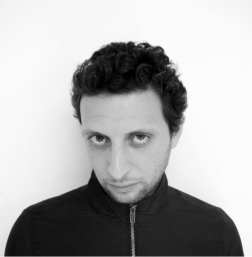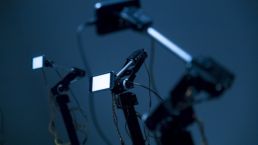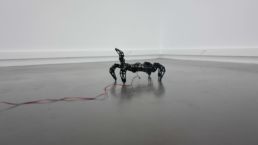Fabien ZOCCO
Lille, FR
Digital art artist working on the question of text and moving objects, graduated from ÉSI in Poitiers in 2012 then from Fresnoy – studio national des arts contemporains – in 2016. Lecturer at Paris VIII ArtTeC, Paris I and at the University of Valencienne in the Master’s “Digital Humanities”.

Biography
Fabien Zocco explores the plastic potential of computer dematerialization, applications and other software. Playing with the infinite possibilities offered by the digital network, he takes up the icons of digital popular culture and virtual aesthetics, to create architectures, forms or futuristic stories.
Not without a hint of derision, he questions our relationship to the new technologies that have invaded our daily lives and probes our relationship to the virtual.” (Sonia Recasens, Young Creation catalog 2014).
His work has notably been presented in France (Le Fresnoy, FRAC Poitou Charentes…), in Mexico (Institut Français d’Amérique Latine, Mexico City), in Canada (gallery of L’UQTR, Trois-Rivières), in Poland ( AIR program, Wroclaw), in Belgium (Transcultures, Mons) and online (The Wrong – New digital art biennale).
Fabien Zocco is a graduate of the Fresnoy-Studio National des Arts Contemporains (2016, congratulations from the jury).
Fabien Zocco's answers
My name is Fabien Zocco, I am an artist, I graduated from the EESI of Poitiers in 2012, as well as from the Fresnoy Studio national des arts contemporains in 2016. As an artist, I work in the field that it is agreed to call digital arts, mainly in two directions, namely that I develop a work around the question of the text. Another work around forms that could be assimilated to robotic sculptures, to moving objects and which implements a questioning of what happens when we give objects movement capabilities.
And beyond that, I have a teaching activity on an ad hoc basis in Paris 8, within the Artec master’s degree as well as next year in Paris 1 and the previous year at the University of Valenciennes, in the as part of a master’s degree in digital humanity, and I live in Lille.
In this association in the title, a notion of creativity and media seems interesting to me, moreover, given the fields that I develop myself, and which are usually also beyond the term digital arts, and are also qualified as works of media art, media art.
It is, it seems to me, effectively a definition which has the merit of being rather rooted in a certain contemporaneity, in the sense that the development of technology effectively induces forms of creation and forms of sharing as well as consumption of images that pass through the media, whether it is a computer, a smartphone or any type of so-called digital “device”, which today enters into this kind of great organology that prevails in creation, manufacturing, to the circulation and contemplation of all types of fixed, animated, virtual, index images, etc.
So, there is indeed a formation of higher education, which could focus a little on this bubbling, this kind of context within the life of images in the social field in the very broad sense, today, it is a bit the issue of a training that would be called “creative media” and which seems to me to be fairly topical.
What seems really important to me at this level is to succeed in combining and articulating an obviously technical dimension of the mastery of the construction of these images, how they are shaped, how they are brought to life simply because that, as in connection with my previous answer, there is a technological dimension, and therefore a need to master the tools, which is obvious today. Finally, as has always been the case, but which today is renewed with all the digital tools in the establishment of what we will call images today in the very broad sense. But what seems to me to be extremely important is precisely not only to focus on this technical dimension, but also to develop a reflection and a more historical and theoretical knowledge around the images. Because making images is important, but knowing what you do with them is just as important, it’s an aspect that, for me, is really extremely important and fundamental. This articulation between the most concrete manufacturing processes of images and the way in which, ultimately, what are these images going to say? How will they be distributed? How will they be circulated? How do the new modes of circulation of images change in a certain way, the nature and the reception, obviously, of these? And how does all of this actually fit together and ultimately make up an overall societal situation? It is really this technical and theoretical articulation that seems to me really essential.
For me, there is an implicit mastery that is necessary, forms of image creation, so it can also be photographic shooting, so fairly traditional images, up to 3D infographic forms or network images , programmed images which will be a bit, let’s say, fixed images and moving images. All these regimes of images which, today, somewhat make up the panel of digital images.
Know a minimum, or even more, of the production environments for this type of image. So this dimension is rather technical.
After knowing also, precisely, the different supports, an image that we look at it on our smartphone, that we look at it projected video, that we look at it on a computer screen, that changes a lot of things, and in its manufacture but also in the reading that we will have of it. And so, there you have it, there is a whole articulation to be said, a technological chain to understand, a workflow that goes from production to reception, this articulation on the technical level seems important to me.
On the other hand, as I was saying, there is also a whole corpus of the history of the media, of the sociology of the media and of the history of art, the history of images which seems to me important to know and to master a minimum to, once again, have a certain idea of what to do and what is the fate, ultimately, of these images that we have put in place. Today, let’s say between an institutional film and an Instagram account, for example, there is a range of environments which, for me, are important to master, as much as each other. In a way, because things happen as much on Instagram as on, for example, regimes of consumption of images or demonstrations of images that are more official or more rooted in a certain reality. But here is precisely this ability to be able to move from one space to another and to have a critical vision too, of how the images are shown seems important to me, So, once again, this articulation between a technical dimension and a theoretical dimension again seems important to me.
Like the modes of production of moving images, in the sense that there is an extremely rapid evolution, even in an acceleration phase in certain aspects. How to think of a training in its ability to adapt precisely to an extremely volatile and extremely rapid evolution of images? It is not a question of training students to master only technologies at a time T, but it is also necessary to give them the capacity to be able to acquire skills at time T +1, because from the moment when we return, let’s say, to this logic, the world is constantly moving. It is also necessary to enter into a logic of movement which would follow the movements of the world a little, without however becoming only passive in relation to these movements. Once again, this is also where the dimension of having a critical tool that also allows us to question this kind of headlong rush comes into play, in a certain way as well. But despite everything, you have to be able, technically and conceptually, to be able to integrate this kind of great flux in perpetual acceleration.
Within digital media, there is a kind of strange paradox in the sense that, in a way, there are both things that are going very fast and accelerating very fast and almost in a contradictory way things that , at the same time, remain relatively or finally move quite little, or even with return shapes. For example, the craze for VR for a few years, replays in a certain way, something that had already happened in the 90s. There are sorts of loops like that, it’s the strangeness of the life of the media, of archaeology, of the media, let’s say, which means that it’s not such a linear story either would tend towards a continuous and gradual acceleration. There are back and forth games like that which are quite interesting and which even have an increasingly lively interest in so-called dead or archaic media, we are now talking about a somewhat vintage dimension of certain media. I think precisely in the field of 3D, for example.
I don’t, but I see a lot of past work with aesthetics that play a bit with a 3D pioneer age of the 80s 90s, which are very contemporary and very interesting. So there really is something like that, a sort of almost paradoxical plurality, of overlapping temporalities. Precisely, it’s something that can be measured from the moment we have a bit of a historical notion of these beautiful images, which are no longer so mobile as that in a certain way. Afterwards, in the more strictly field of contemporary art, where I actually find myself, this plurality of knowledge and mastery of production environments and images in the broad sense is necessarily an asset and a more important card for precisely to be able to both produce work that involves the making of images, as such, but also to have an aesthetic critical look around these same images.
What is paradoxical as far as I am concerned is that finally, there is a putting in the background, finally of the notion of image in my work, in the sense that, finally, for some time now, I have been concentrating rather on the text, which can of course be read on screen. And then, I am more and more interested in the object, therefore in the robot object, and finally in technological art forms, but which bring in other fields of skills and creation.
What seems to me to be taking shape precisely as a trend in the future is a kind of mix, a bit between many things, both so-called archaic forms, old forms in terms of historical temporality, and forms that are much more contemporary. And things that range from objects, I’m thinking today of everything that happens with connected objects, the Internet of objects, behavioral objects and what happens on screens.
So I think there’s also kind of a ‘spillover’ of what’s commonly referred to as digital, which is spilling over the screen in a way, and I think a lot of things are going to happen play on it. For example, what comes to mind is the case of so-called “intelligent” textiles, there are a lot of things that happen in this type of research field which are ultimately ways of going beyond the strict environment screen which remains, obviously, very, very present. But here it is, I think there is something at play at this level of a sort of digital infusion through environments that were not his, in any case, not his environment of election so far. And I think that’s going to be a trend that’s potentially going to gain even more weight in the times to come.
Typically, artificial intelligence is something that I use as a tool to produce often rather semantic content, I didn’t use it too much to make images, but rather to make text. At the same time, it is the use of a tool with a critical look at today: what is artificial intelligence in the societal field? At the same time something that goes from the fad, with extremely trivial things because artificial intelligence is something that you can find when you connect to your online bank account to be able to converse with a virtual agent who will guide us to find our way, up to questions of a vast anthropological and philosophical order on the future of humanity. So there’s a dimension like that in AI that’s extremely broad and ultimately focal, let’s say. For me, AI is both something which is a tool, but which is also a subject, a certain way of working and it precisely illustrates this articulation between technical know-how, in the sense that, effectively , it works for me, (EX: like my robots), and code phases to set up their mode of operation. But at the same time, it is also a social and aesthetic object, so you need to have historical, aesthetic, conceptual tools to be able to have a broader vision than the technical dimension of this object, that is to say in what AI or robotics today, resonates and makes sense, in the aesthetic sense, of course, but also political, societal, anthropological, etc… Somehow, it is an illustration, once again, of what I was saying about the previous answers.
Regarding the use of the code. For my part, indeed, and there, it will also illustrate something that I said before on these questions a little about the “spreading” of the digital through environments which were not its until now. But in fact, that’s the whole point of my work somewhere, the only common denominator in my pieces today is that they proceed from a place of a dimension, of a writing that involves computer code. But this writing can very well end up in a video installation projected from software, in a moving robotic object, in a film whose dialogues have been generated by artificial intelligence, in a paper book edition which will present a text generated by an AI. Once again, it illustrates how, from this central language, let’s say digital, which is the code, forms, objects of an extremely heterogeneous nature can find themselves as a receptacle in this writing process.
It often happens that I work with other people on extremely targeted themes and skills. Somewhere, depending on the place, which can cover a fairly wide range, ranging from a specific skill to setting up elements, the technical implementation of which I do not master, 3D, for example , which is not part of my technical skills. But which I could very well need in the context of my practice. It could be skills that would go into this term of services, and for once, I would actually be quite attached, both to a technical quality in the know-how, but also in a conceptual capacity, let’s say, so as to also be able to not just be in a task execution relationship, or I would ask someone to exclusively do technical work, although obviously that would be the main object, but also to have a capacity for discussion around of the dimension to which the intervention of the person belongs.
Personally, I don’t believe much in training only technicians. Today, the complexity of things means that technicians without any general or more cultural skills, let’s say, seem quite risky to me, I see it from having discussed it precisely with engineers, for example, or as I teaches in university masters, to also see the training organization charts, of certain training courses. It is something that is increasingly sought after. In any case, there is always this dimension in one place, often in technical training, of also bringing in a more social science dimension, and there again, that seems to me, something that needs to be insisted on.
It seems to me that the very foundation of an artistic approach in its contemporary conception is its ability to resonate with a reality which is that of the world in which we live. As I said, AI today is a subject that could not be more topical. So from there, it’s both, and it’s obviously legitimate to deal with it in the artistic, but that implies, de facto, a reflection accordingly on the part of the artists who will seize this theme.





